Forest and Land Fires Are Mainly Associated with Deforestation in Riau Province, Indonesia
Abstract
1. Introduction
2. Materials and Methods
3. Results
4. Discussion
5. Conclusions
Author Contributions
Funding
Acknowledgments
Conflicts of Interest
Appendix A
| Class | Code | Description |
|---|---|---|
| Primary dryland forest | 2001 (Hp) | Natural tropical forests grow on non-wet habitat including lowland, upland, and montane forests with no signs of logging activities. The forest is including pygmies and heath forest and forest on ultramafic and lime-stone, as well as coniferous, deciduous and mist or cloud forest. |
| Secondary dryland forest | 2002 (Hs) | Natural tropical forest grow on non-wet habitat including lowland, upland, and montane forests that exhibit signs of logging activities indicated by patterns and spotting of logging. The forest is including pygmies and heath forest and forest on ultramafic and lime-stone, as well as coniferous, deciduous and mist or cloud forest. |
| Primary swamp forest | 2005 (Hrp) | Natural tropical forest grow on wet habitat including brackish swamp, sago and peat swamp, with no signs of logging activities. |
| Secondary swamp forest | 20051 (Hrs) | Natural tropical forest grow on wet habitat including brackish swamp, sago and peat swamp that exhibit signs of logging activities indicated by patterns and spotting of logging. |
| Primary mangrove forest | 2004 (Hmp) | Inundated forest with access to sea/brackish water and dominated by species of mangrove and Nipa (Nipa frutescens) that has no signs of logging activities. |
| Secondary mangrove forest | 20041 (Hms) | Inundated forest with access to sea/brackish water and dominated by species of mangrove and Nipa (Nipa frutescens) that exhibit signs of logging activities indicated by patterns and spotting of logging. |
| Plantation forest | 2006 (Ht) | Planted forest including areas of reforestation, industrial plantation forest and community plantation forest. |
| Non-Forest Dry shrub | 2007 (B) | Highly degraded log over areas on non-wet habitat that are ongoing process of succession but not yet reach stable forest ecosystem, having natural scattered trees or shrubs. |
| Wet shrub/swampy shrub | 20071 (Br) | Highly degraded log over areas on wet habitat that are ongoing process of succession but not yet reach stable forest ecosystem, having natural scattered trees or shrubs. |
| Savanna and Grasses | 3000 (S) | Areas with grasses and scattered natural trees and shrubs. This is typical of natural ecosystem and appearance on Sulawesi Tenggara, Nusa Tenggara Timur, and south part of Papua island. This type of cover could be on wet or non-wet habitat. |
| Dry Agriculture | 20091 (Pt) | All land covers associated to agriculture activities on dry/non-wet land, such as moor (tegalan), mixed garden and agriculture fields (ladang) |
| Mixed dry agriculture | 20092 (Pc) | All land covers associated to agriculture activities on dry/non-wet land that mixed with shrubs, thickets, and log over forest. Tis cover type often results of shifting cultivation and its rotation, including on karts |
| Estate crop | 2010 (Pk) | Estate areas that has been planted, mostly with perennials crops or other agriculture trees commodities |
| Paddy field | 20093 (Sw) | Agriculture areas on wet habitat, especially for paddy, that typically exhibit dyke patterns (pola pematang). Tis cover type includes rainfed, seasonal paddy field, and irrigated paddy fields |
| Transmigration areas | 20122 (Tr) | Kind of unique settlement areas that exhibit association of houses and agroforestry and/or garden at surrounding |
| Fish pond/aquaculture | 20094 (Tm) | Areas exhibit aquaculture activities including fish ponds, shrimp ponds or salt ponds |
| Bare ground/Bare soil | 2014 (T) | Bare grounds and areas with no vegetation cover yet, including open exposure areas, craters, sandbanks, sediments, and areas post fire that has not yet exhibit regrowth |
| Mining areas | 20141 (Tb) | Mining areas exhibit open mining activities such as open-pit mining including tailing ground |
| Settlement areas | 2012 (Pm) | Settlement areas including rural, urban, industrial and other settlements with typical appearance |
| Port and harbor | 20121 (Bdr/Plb) | Sighting of port and harbor that big enough to independently delineated as independent object |
| Open water | 5001 (A) | Sighting of open water including ocean, rivers, lakes, and ponds |
| Open swamp | 50011 (Rw) | Sighting of open swamp with few vegetation |
| Clouds and no-data | 2500 (Aw) | Sighting of clouds and clouds shadow with size more than 4 cm2 at 100,000 scales display. |
References
- Kiely, L.; Spracklen, D.V.; Wiedinmyer, C.; Conibear, L.; Reddington, C.L.; Archer-Nicholls, S.; Lowe, D.; Arnold, S.R.; Knote, C.; Khan, M.F.; et al. New estimate of particulate emissions from Indonesian peat fires in 2015. Atmos. Chem. Phys. 2019, 19, 11105–11121. [Google Scholar] [CrossRef]
- Huijnen, V.; Wooster, M.J.; Kaiser, J.W.; Gaveau, D.L.A.; Flemming, J.; Parrington, M.; Inness, A.; Murdiyarso, D.; Main, B.; van Weele, M. Fire carbon emissions over maritime southeast Asia in 2015 largest since 1997. Sci. Rep. 2016, 6, 26886. [Google Scholar] [CrossRef] [PubMed]
- Marlier, M.E.; DeFries, R.S.; Voulgarakis, A.; Kinney, P.L.; Randerson, J.T.; Shindell, D.T.; Chen, Y.; Faluvegi, G. El Niño and health risks from landscape fire emissions in Southeast Asia. Nat. Clim. Chang. 2013, 3, 131–136. [Google Scholar] [CrossRef] [PubMed]
- Crippa, P.; Castruccio, S.; Archer-Nicholls, S.; Lebron, G.B.; Kuwata, M.; Thota, A.; Sumin, S.; Butt, E.; Wiedinmyer, C.; Spracklen, D.V. Population exposure to hazardous air quality due to the 2015 fires in Equatorial Asia. Sci. Rep. 2016, 6, 37074. [Google Scholar] [CrossRef]
- Koplitz, N.S.; Mickley, L.J.; Marlier, M.E. Public health impacts of the severe haze in Equatorial Asia in September–October 2015: Demonstration of a new framework for informing fire management strategies to reduce downwind smoke exposure. Environ. Res. Lett. 2016, 11, 094023. [Google Scholar] [CrossRef]
- Page, S.E.; Siegert, F.; Rieley, J.O.; Boehm, H.V.; Jaya, A.; Limin, S. The amount of carbon released from peat and forest fires in Indonesia during 1997. Nature 2002, 420, 61–65. [Google Scholar] [CrossRef]
- Staal, A.; van Nes, E.H.; Hantson, S.; Holmgren, M.; Dekker, S.C.; Pueyo, S.; Xu, C.; Scheffer, M. Resilience of tropical tree cover: The roles of climate, fire, and herbivory. Glob. Chang. Biol. 2018, 24, 5096–5109. [Google Scholar] [CrossRef]
- Field, R.D.; van der Werf, G.R.; Fanin, T.; Fetzer, E.J.; Fuller, R.; Jethva, H.; Levy, R.; Livesey, N.J.; Luo, M.; Torres, O.; et al. Indonesian fire activity and smoke pollution in 2015 show persistent nonlinear sensitivity to El Nino-induced drought. Proc. Natl. Acad. Sci. USA 2016, 113, 9204–9209. [Google Scholar] [CrossRef]
- Gaveau, D.L.; Salim, M.A.; Hergoualc’h, K.; Locatelli, B.; Sloan, S.; Wooster, M.; Marlier, M.E.; Molidena, E.; Yaen, H.; DeFries, R.; et al. Major atmospheric emissions from peat fires in Southeast Asia during non-drought years: Evidence from the 2013 Sumatran fires. Sci. Rep. 2014, 4, 6112. [Google Scholar] [CrossRef]
- Hansen, M.C.; Potapov, P.V.; Moore, R.; Hancher, M.; Turubanova, S.A.; Tyukavina, A.; Thau, D.; Stehman, S.V.; Goetz, S.J.; Loveland, T.R.; et al. High-Resolution Global Maps of 21st-Century Forest Cover Change. Science 2013, 342, 850–853. [Google Scholar] [CrossRef]
- Margono, B.A.; Potapov, P.V.; Turubanova, S.; Stolle, F.; Hansen, M.C. Primary forest cover loss in Indonesia over 2000–2012. Nat. Clim. Chang. 2014, 4, 730–735. [Google Scholar] [CrossRef]
- Vadrevu, K.; Ohara, T.; Justice, C. Land cover, land use changes and air pollution in Asia: A synthesis. Environ. Res. Lett. 2017, 12, 120201. [Google Scholar] [CrossRef]
- Gaveau, D.L.A.; Sheil, D.; Husnayaen; Salim, M.A.; Arjasakusuma, S.; Ancrenaz, M.; Pacheco, P.; Meijaard, E. Rapid conversions and avoided deforestation: Examining four decades of industrial plantation expansion in Borneo. Sci. Rep. 2016, 6, 32017. [Google Scholar] [CrossRef] [PubMed]
- Vadrevu, K.P.; Lasko, K.; Giglio, L.; Schroeder, W.; Biswas, S.; Justice, C. Trends in Vegetation fires in South and Southeast Asian Countries. Sci. Rep. 2019, 9, 7422. [Google Scholar] [CrossRef] [PubMed]
- Marlier, M.E.; DeFries, R.S.; Kim, P.S.; Koplitz, S.N.; Jacob, D.J.; Mickley, L.J.; Myers, S.S. Fire emissions and regional air quality impacts from fires in oil palm, timber, and logging concessions in Indonesia. Environ. Res. Lett. 2015, 10, 085005. [Google Scholar] [CrossRef]
- Adrianto, H.A.; Spracklen, D.V.; Arnold, S.R. Relationship between Fire and Forest Cover Loss in Riau Province, Indonesia between 2001 and 2012. Forests 2019, 10, 889. [Google Scholar] [CrossRef]
- Carmenta, R.; Parry, L.; Blackburn, A.; Vermeylen, S.; Barlow, J. Understanding Human-Fire Interactions in Tropical Forest Regions: A Case for Interdisciplinary Research across the Natural and Social Sciences. Ecol. Soc. 2011, 16, 53. [Google Scholar] [CrossRef]
- Margono, B.A.; Usman, A.B.; Budiharto; Sugardiman, R.A. Indonesia’s Forest Resource Monitoring. Indones. J. Geogr. 2016, 48. [Google Scholar] [CrossRef]
- Randerson, J.T.; Chen, G.R.; van der Werf, B.M.; Rogers, D.C.M. Global burned area and biomass burning emissions from small fires. J. Geophys. Res. Biogeosci. 2012, 117. [Google Scholar] [CrossRef]
- Giglio, L.; Schroeder, W.; Justice, C.O. The collection 6 MODIS active fire detection algorithm and fire products. Remote Sens. Environ. 2016, 178, 31–41. [Google Scholar] [CrossRef]
- Giglio, L.; Schroeder, W.; Hall, J.V.; Justice, C.O. MODIS Collection 6 Active Fire Product User’s Guide Revision B. NASA: Washington, DC, USA, 2018. [Google Scholar]
- Vadrevu, K.P.; Csiszar, I.; Ellicott, E.; Giglio, L.; Badarinath, K.V.S.; Vermote, E.; Justice, C. Hotspot Analysis of Vegetation Fires and Intensity in the Indian Region. IEEE J. Sel. Top. Appl. Earth Obs. Remote Sens. 2013, 6, 224–238. [Google Scholar] [CrossRef]
- Fornacca, D.; Ren, G.; Xiao, W. Performance of Three MODIS Fire Products (MCD45A1, MCD64A1, MCD14ML), and ESA Fire_CCI in a Mountainous Area of Northwest Yunnan, China, Characterized by Frequent Small Fires. Remote Sens. 2017, 9, 1131. [Google Scholar] [CrossRef]
- MoEF. Standard Procedure for Field Checking of Hotspot Information and/or Forest and Land Fire Information. 2018. Available online: http://ditjenppi.menlhk.go.id/reddplus/images/adminppi/permen/P.8_2018.pdf (accessed on 6 December 2019).
- Tacconi, L.; Moore, P.F.; Kaimowitz, D. Fires in tropical forests—What is really the problem? lessons from Indonesia. Mitig. Adapt. Strateg. Glob. Chang. 2007, 12, 55–66. [Google Scholar] [CrossRef]
- Busch, J.; Ferretti-Gallon, K.; Engelmann, J.; Wright, M.; Austin, K.G.; Stolle, F.; Turubanova, S.; Potapov, P.V.; Margono, B.; Hansen, M.C.; et al. Reductions in emissions from deforestation from Indonesia’s moratorium on new oil palm, timber, and logging concessions. Proc. Natl. Acad. Sci. USA 2015, 112, 1328–1333. [Google Scholar] [CrossRef] [PubMed]
- Chazdon, R.L.; Broadbent, E.N.; Rozendaal, D.M.A.; Bongers, F.; Zambrano, A.M.A.; Aide, T.M.; Balvanera, P.; Becknell, J.M.; Boukili, V.; Brancalion, P.H.S.; et al. Carbon sequestration potential of second-growth forest regeneration in the Latin American tropics. Sci. Adv. 2016, 2, e1501639. [Google Scholar] [CrossRef]
- Chazdon, R.L.; Peres, C.A.; Dent, D.; Sheil, D.; Lugo, A.E.; Lamb, D.; Stork, N.E.; Miller, S.E. The potential for species conservation in tropical secondary forests. Conserv. Biol. 2009, 23, 1406–1417. [Google Scholar] [CrossRef]
- Gardner, T.A.; Barlow, J.; Chazdon, R.; Ewers, R.M.; Harvey, C.A.; Peres, C.A.; Sodhi, N.S. Prospects for tropical forest biodiversity in a human-modified world. Ecol. Lett. 2009, 12, 561–582. [Google Scholar] [CrossRef]
- Noojipady, P.; Morton, D.C.; Schroeder, W.; Carlson, K.M.; Huang, C.; Gibbs, H.K.; Burns, D.; Walker, N.F.; Prince, S.D. Managing fire risk during drought: The influence of certification and El Niño on fire-driven forest conversion for oil palm in Southeast Asia. Earth Syst. Dyn. 2017, 8, 749–771. [Google Scholar] [CrossRef]
- Reiche, J.; Verhoeven, R.; Verbesselt, J.; Hamunyela, E.; Wielaard, N.; Herold, M. Characterizing Tropical Forest Cover Loss Using Dense Sentinel-1 Data and Active Fire Alerts. Remote Sens. 2018, 10, 777. [Google Scholar] [CrossRef]
- Sze, J.S.; Jefferson; Lee, J.S.H. Evaluating the social and environmental factors behind the 2015 extreme fire event in Sumatra, Indonesia. Environ. Res. Lett. 2019, 14, 015001. [Google Scholar] [CrossRef]
- Harrison, M.E.; Ottay, J.B.; D’Arcy, L.J.; Cheyne, S.M.; Anggodo; Belcher, C.; Cole, L.; Dohong, A.; Ermiasi, Y.; Feldpausch, T.; et al. Tropical forest and peatland conservation in Indonesia: Challenges and directions. People Nat. 2019. [Google Scholar] [CrossRef]
- Morton, D.C.; Defries, R.S.; Randerson, J.T.; Giglio, L.; Schroeder, W.; van der Werf, G.R. Agricultural intensification increases deforestation fire activity in Amazonia. Glob. Chang. Biol. 2008, 14, 2262–2275. [Google Scholar] [CrossRef]
- Reddington, C.L.; Butt, E.W.; Ridley, D.A.; Artaxo, P.; Morgan, W.T.; Coe, H.; Spracklen, D.V. Air quality and human health improvements from reductions in deforestation-related fire in Brazil. Nat. Geosci. 2015, 8, 768–771. [Google Scholar] [CrossRef]
- Van Marle, M.J.E.; Field, R.D.; van der Werf, G.R.; de Wagt, I.A.E.; Houghton, R.A.; Rizzo, L.V.; Artaxo, P.; Tsigaridis, K. Fire and deforestation dynamics in Amazonia (1973–2014). Glob. Biogeochem. Cycles 2017, 31, 24–38. [Google Scholar] [CrossRef]
- Lima, A.; Silva, T.S.F.; de Aragão, L.E.O.E.C.; de Feitasa, R.M.; Adami, M.; Formaggio, A.R.; Shimabukuro, Y.E. Land use and land cover changes determine the spatial relationship between fire and deforestation in the Brazilian Amazon. Appl. Geogr. 2012, 34, 239–246. [Google Scholar] [CrossRef]
- Fanin, T.; van der Werf, G.R. Relationships between burned area, forest cover loss, and land cover change in the Brazilian Amazon based on satellite data. Biogeosciences 2015, 12, 6033–6043. [Google Scholar] [CrossRef]
- Aragão, C.L.E.O.; Shimabukuro, Y.E. The Incidence of Fire in Amazonian Forests with Implications for REDD. Science 2010, 328, 1275–1278. [Google Scholar] [CrossRef]
- Morgan, W.T.; Darbyshire, E.; Spracklen, D.V.; Artaxo, P.; Coe, H. Non-deforestation drivers of fires are increasingly important sources of aerosol and carbon dioxide emissions across Amazonia. Sci. Rep. 2019, 9, 16975. [Google Scholar] [CrossRef]
- Barlow, J.; Berenguer, E.; Carmenta, R.; França, F. Clarifying Amazonia’s burning crisis. Glob. Chang. Biol. 2019. [Google Scholar] [CrossRef]
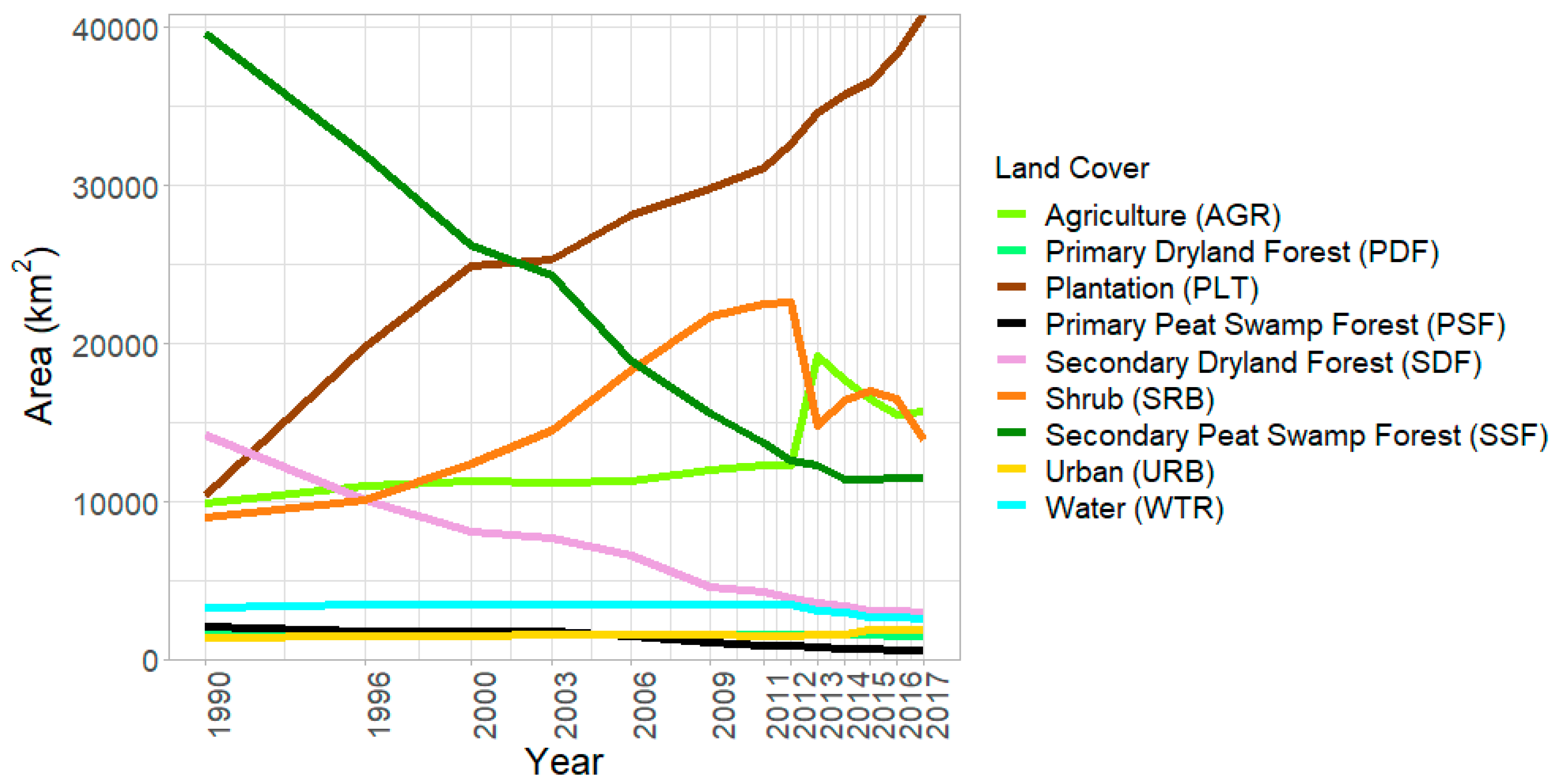
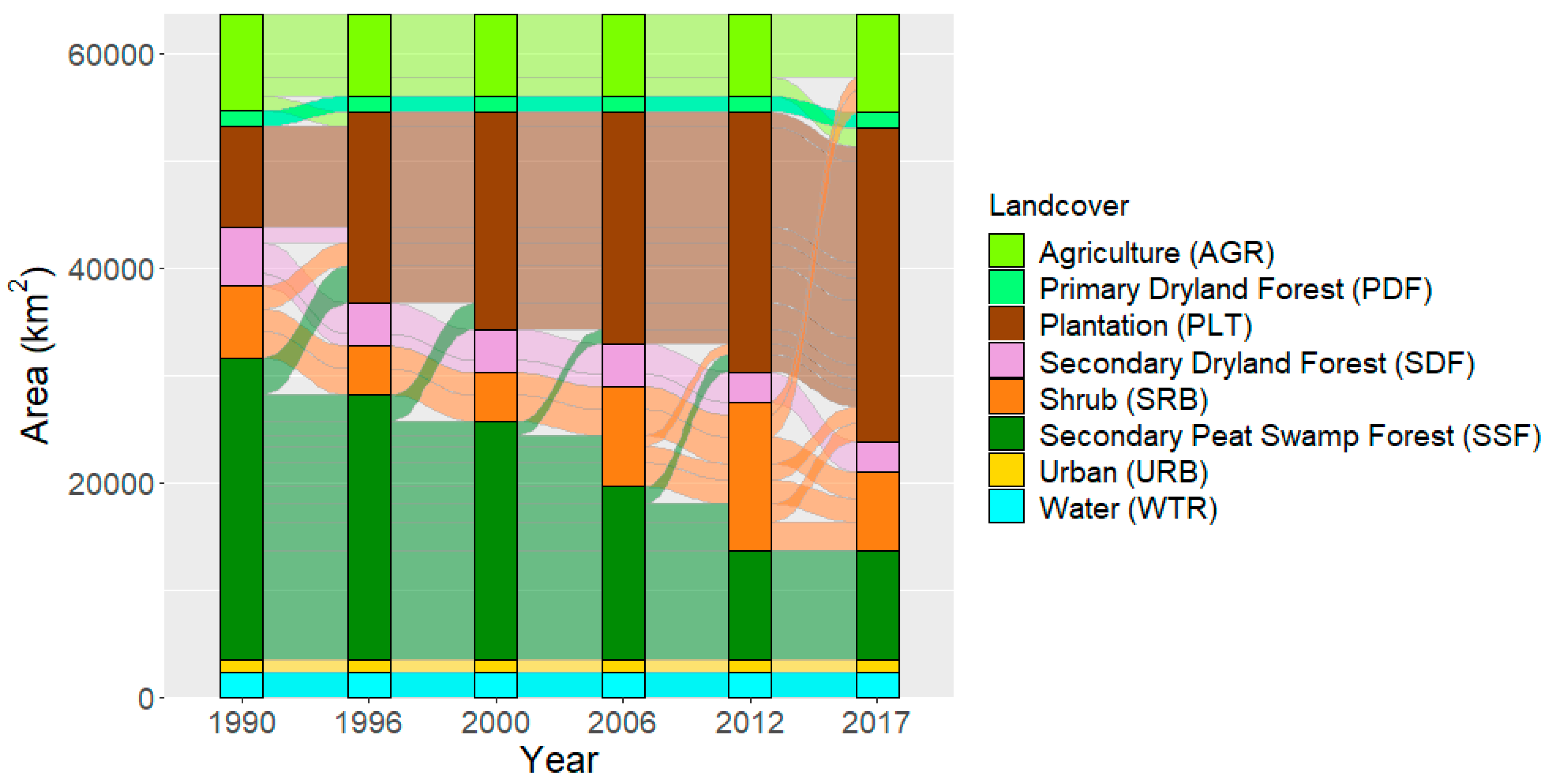
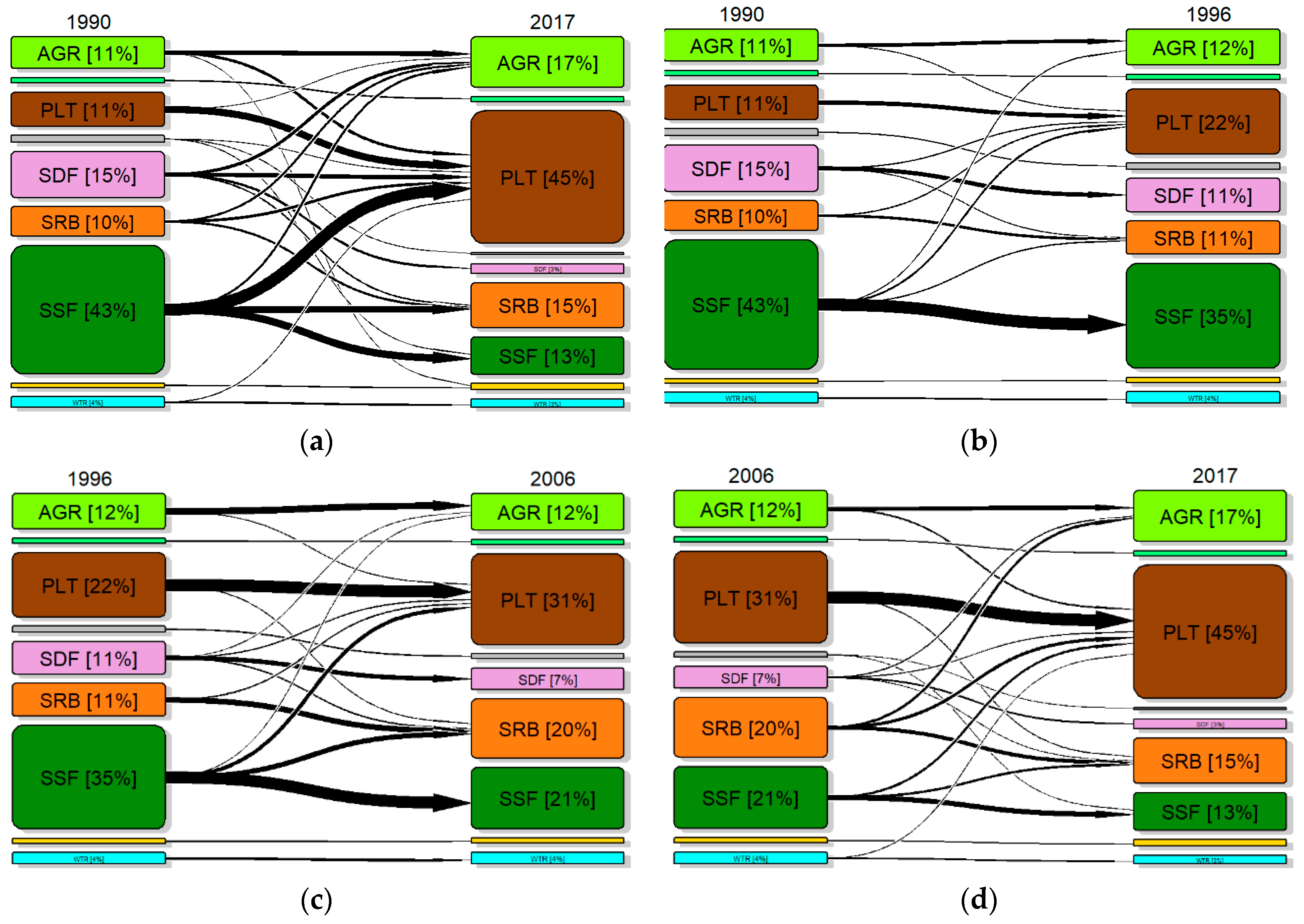
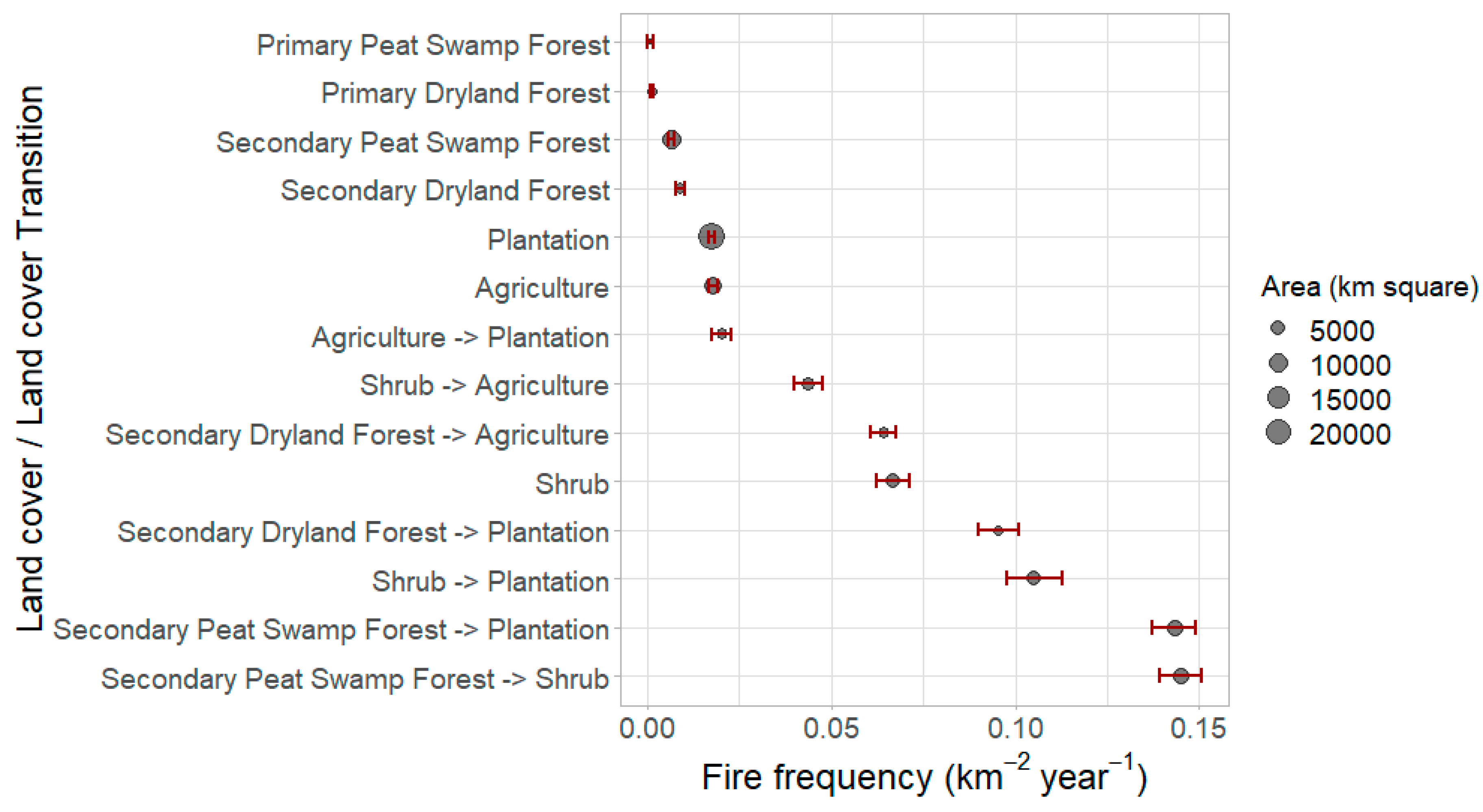
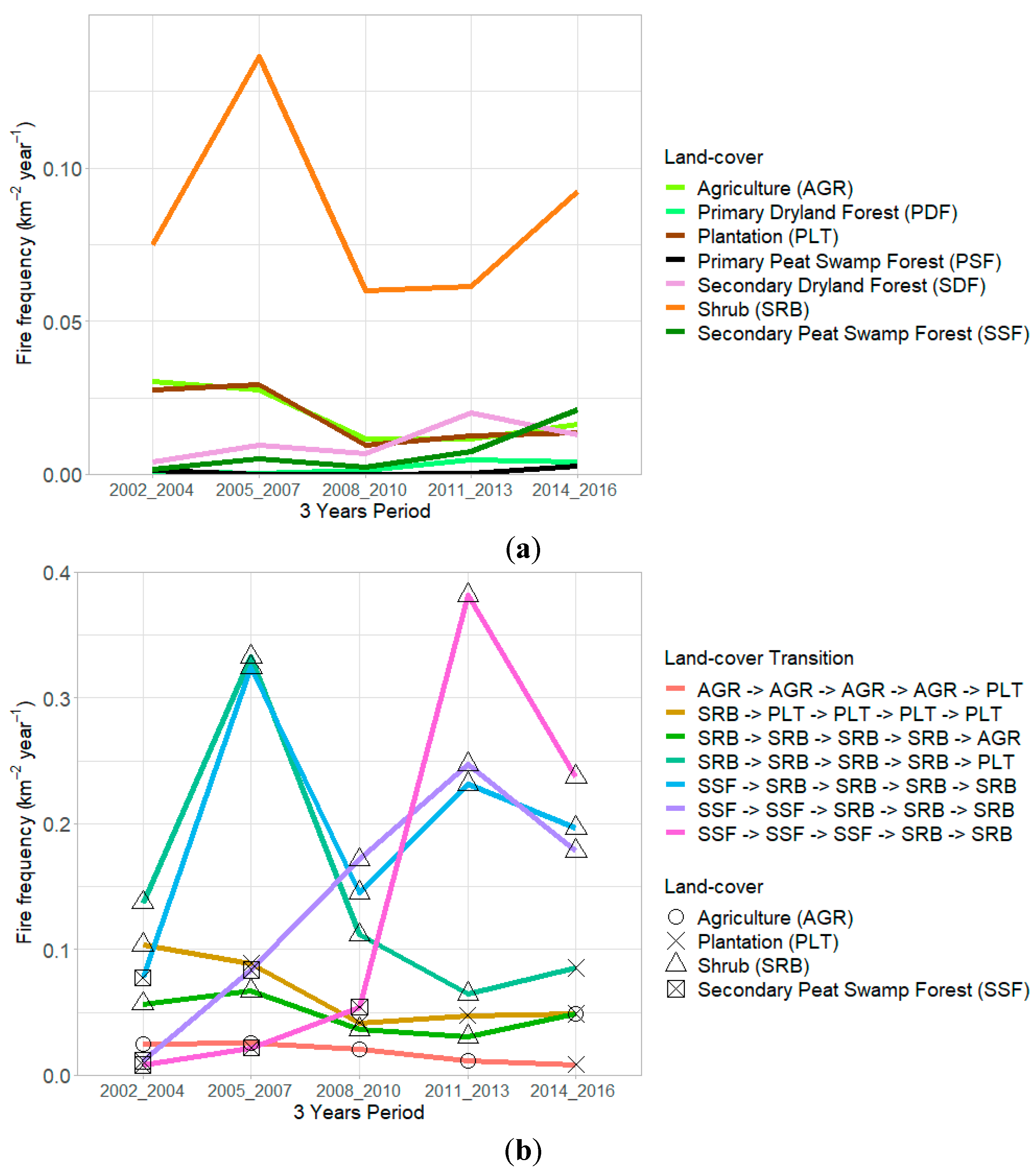
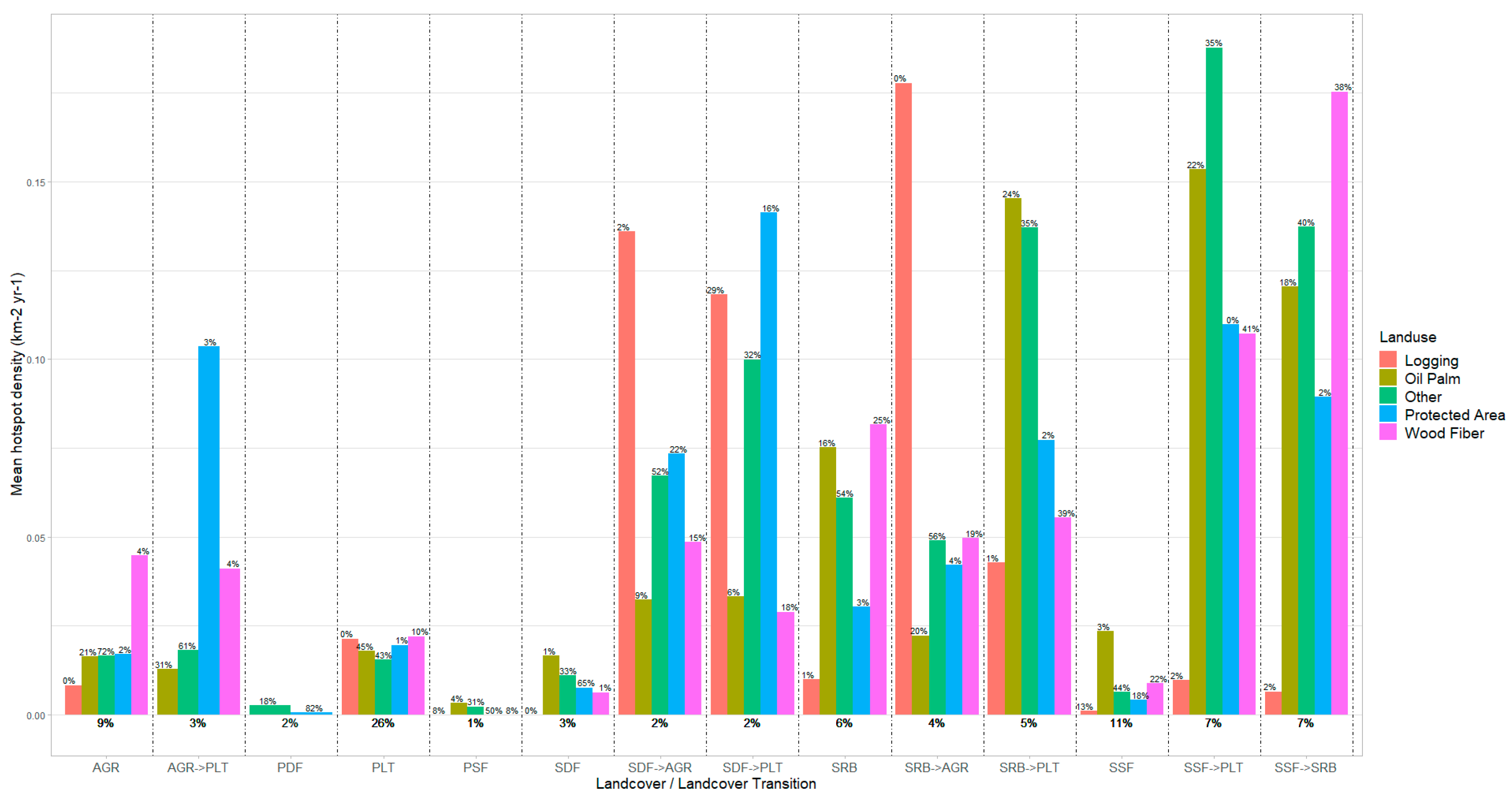
| Grouped Land-Cover | Code | Original Land-Cover Types and Code |
|---|---|---|
| Primary dryland forest | Primary dryland forest (2001) | |
| Primary peat swamp forest | PSF | Primary swamp forest (2005), Primary mangrove forest (2004) |
| Secondary dryland forest | SDF | Secondary dryland forest (2002) |
| Secondary peat swamp forest | SSF | Secondary swamp forest (20051), Secondary mangrove forest (20041) |
| Plantation | PLT | Plantation forest (2006), Estate crop (2010) |
| Shrub | SRB | Non-Forest Dry shrub (2007), Wet shrub/swampy shrub (20071), Savanna and Grasses (3000), Bareground/Bare soil (2014) |
| Water | WTR | Fish pond/aquaculture (20094), Open water (5001), Open swamp (50011) |
| Agriculture | AGR | Dry Agriculture (20091), Mixed dry agriculture (20092), Paddy Field (20093) |
| Urban | URB | Settlement areas (2012), Port and Harbor (20121), Transmigration Area (20122), Mining_Area (20141) |
| Initial Type | End Type | Transition | 1990–1996 | 1996–2000 | 2000–2006 | 2006–2017 | Sum |
|---|---|---|---|---|---|---|---|
| Secondary Peat Swamp Forest | Plantation | SSF→PLT | 3781 | 2698 | 1825 | 3981 | 12,285 |
| Shrub | SSF→SRB | 2286 | 2462 | 5713 | 4150 | 14,611 | |
| Agriculture | SSF→AGR | 1700 | 485 | 76 | 487 | 2748 | |
| Secondary Dryland Forest | Plantation | SDF→PLT | 2012 | 738 | 235 | 1259 | 4244 |
| Shrub | SDF→SRB | 1422 | 981 | 1182 | 615 | 4200 | |
| Agriculture | SDF→AGR | 583 | 347 | 77 | 1751 | 2758 | |
| Shrub | Plantation | SRB→PLT | 2417 | 1016 | 1912 | 5747 | 11,092 |
| Agriculture | SRB→AGR | 376 | 205 | 54 | 4742 | 5377 |
© 2019 by the authors. Licensee MDPI, Basel, Switzerland. This article is an open access article distributed under the terms and conditions of the Creative Commons Attribution (CC BY) license (http://creativecommons.org/licenses/by/4.0/).
Share and Cite
Adrianto, H.A.; Spracklen, D.V.; Arnold, S.R.; Sitanggang, I.S.; Syaufina, L. Forest and Land Fires Are Mainly Associated with Deforestation in Riau Province, Indonesia. Remote Sens. 2020, 12, 3. https://doi.org/10.3390/rs12010003
Adrianto HA, Spracklen DV, Arnold SR, Sitanggang IS, Syaufina L. Forest and Land Fires Are Mainly Associated with Deforestation in Riau Province, Indonesia. Remote Sensing. 2020; 12(1):3. https://doi.org/10.3390/rs12010003
Chicago/Turabian StyleAdrianto, Hari A., Dominick V. Spracklen, Stephen R. Arnold, Imas S. Sitanggang, and Lailan Syaufina. 2020. "Forest and Land Fires Are Mainly Associated with Deforestation in Riau Province, Indonesia" Remote Sensing 12, no. 1: 3. https://doi.org/10.3390/rs12010003
APA StyleAdrianto, H. A., Spracklen, D. V., Arnold, S. R., Sitanggang, I. S., & Syaufina, L. (2020). Forest and Land Fires Are Mainly Associated with Deforestation in Riau Province, Indonesia. Remote Sensing, 12(1), 3. https://doi.org/10.3390/rs12010003






